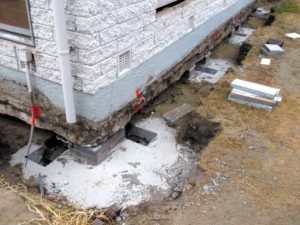There are many ways to repair a foundation, but not all are created equal. Some methods are more expensive than others, some are more time-consuming, and some are ineffective. It’s important to know the different types of foundation repair methods so that you can make an informed decision about which one is right for your home. If you are looking for unmatched foundation repair service in Woodridge, click site here and get access to expert advice and exceptional services.
- Concrete Slabjacking
This is one of the most common types of foundation repair. It involves pumping concrete beneath the slab to raise it back into place. Slabjacking is usually only effective for minor settlings. One of the major advantages of concrete slumping is that it’s relatively inexpensive and can be done quickly.
- Steel Piers
Steel piers are also another common method of foundation repair. It involves driving steel piers deep into the ground until they reach solid bedrock. The piers are then attached to the foundation and used to lift it back into place. Steel piers are more expensive than concrete slab jacking; they are also much more durable and effective in major settling issues. Steel piers can be used for both new construction and existing homes.
- Helical Piers
This type of foundation repair is similar to steel piers, but instead of being driven into the ground, helical piers are screwed into the ground. Helical piers are also used to reach a solid bedrock and lift the foundation back into place. Helical piers are more expensive than concrete slab jacking, but they are also more durable and effective in major settling issues. Helical piers can be used for both new construction and existing homes.
- Plate Anchors
Plate anchors are a foundation repair used to stabilize a foundation that has already been repaired. Plate anchors are placed around the perimeter of the foundation and attached to the foundation with steel cables. The cables are then tightened to hold the foundation in place. Plate anchors are not typically used for new construction but can be used for existing homes that have already been repaired. The main advantage of plate anchors is that they are very strong and can be used to stabilize a foundation that has already been repaired.
- Grouting
Grouting is a type of foundation repair that involves injecting grout into voids beneath the foundation. Grouting fills the voids and helps to stabilize the foundation. Grouting is often used in conjunction with other types of foundation repair, such as steel piers or helical piers. Grouting is ideal for foundations that have already been repaired but still show signs of settling.
- Mudjacking
Mudjacking is a type of foundation repair that involves pumping mud beneath the foundation to raise it back into place. Mudjacking is usually only effective for minor settling. One of the advantages of mudjacking is that it can be done quickly and is relatively inexpensive. Mudjacking is mostly used in conjunction with other types of foundation repair as it is not as effective on its own.
- Polyurethane Foam Injection
This foundation repair involves injecting polyurethane foam into voids beneath the foundation. The foam expands and fills the voids, helping to stabilize the foundation. Polyurethane foam injection is ideal for foundations that have already been repaired but still show signs of settling. It is often used in conjunction with other types of foundation repair, such as steel piers or helical piers, to give it extra support.
- Helical Tiebacks
This type of foundation repair involves installing helical tiebacks around the perimeter of the foundation. The tiebacks are then connected to the foundation with steel cables. The cables are then tightened to hold the foundation in place. Helical tiebacks are typically used for new construction but can also be used for existing homes. The main advantage of helical tiebacks is that they are very strong and can be used to stabilize a foundation.
There are many different types of foundation repair methods available, and it’s important to choose the right one for your home. Slabjacking, steel piers, and helical piers are common types of foundation repair. Plate anchors, grouting, mudjacking, and polyurethane foam injection are also effective methods of foundation repair. Helical tiebacks are typically used for new construction but can also be used for existing homes. When choosing a foundation repair method, it’s important to consider the severity of the problem, the cost of the repair, and the durability of the repair.
